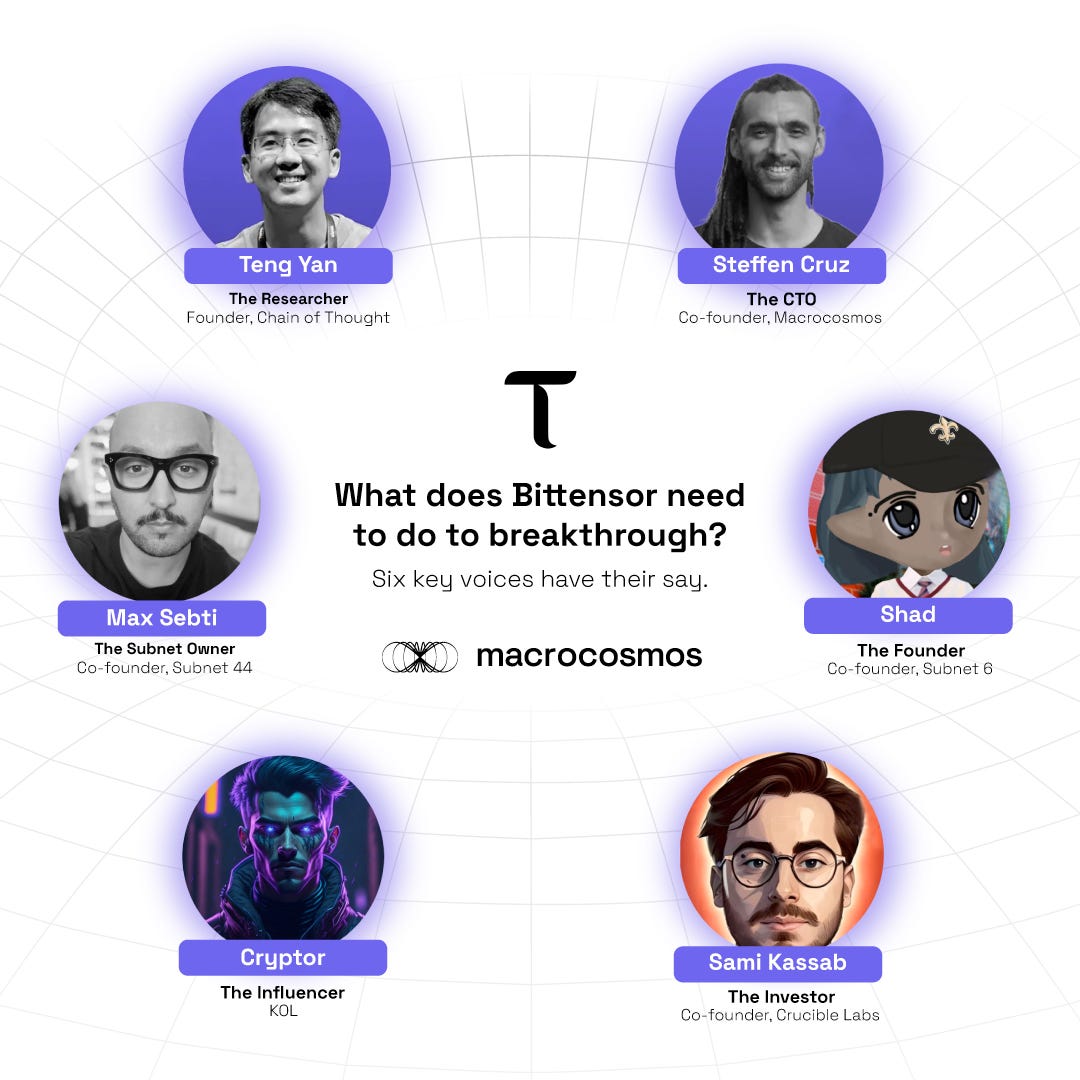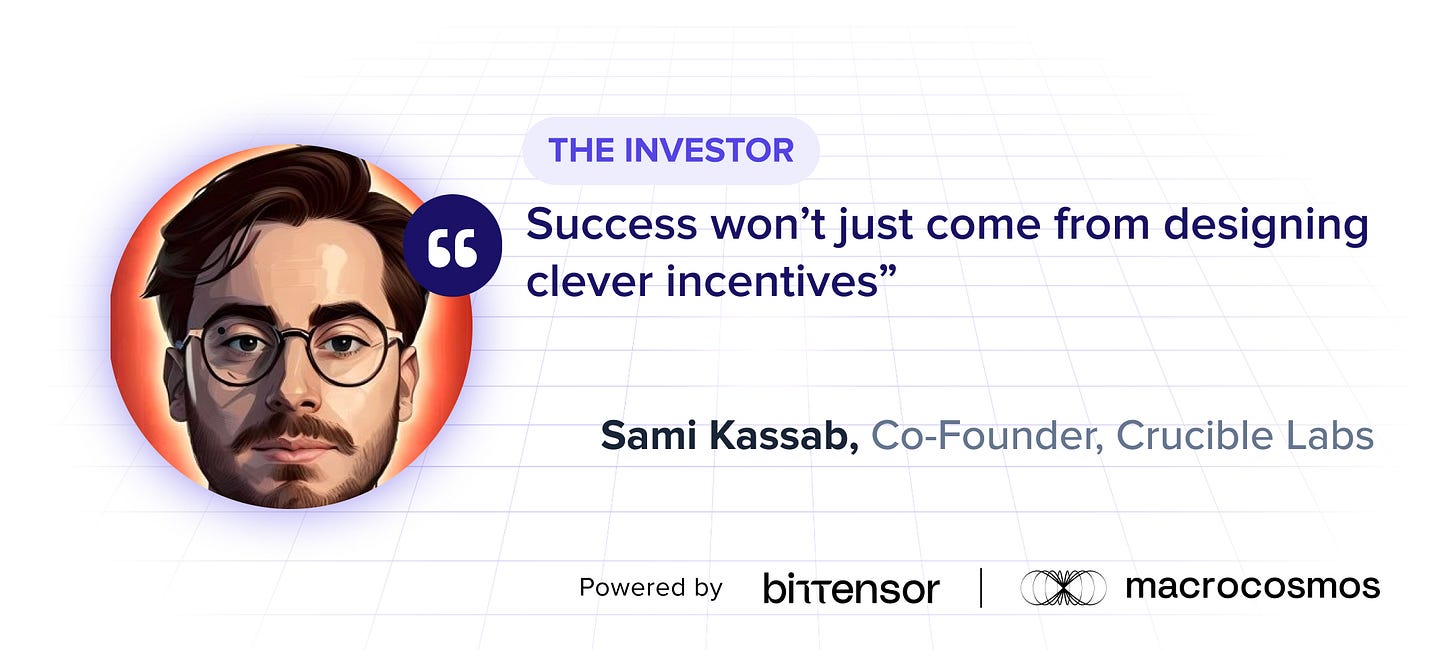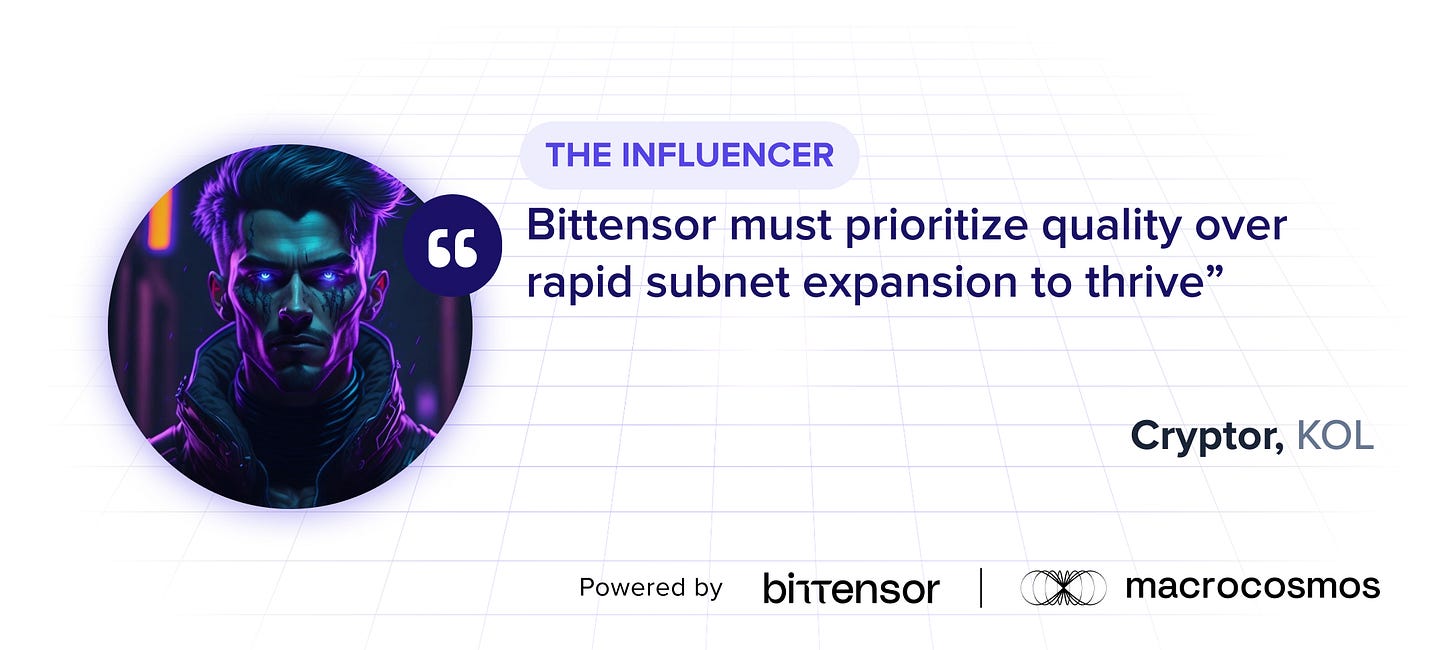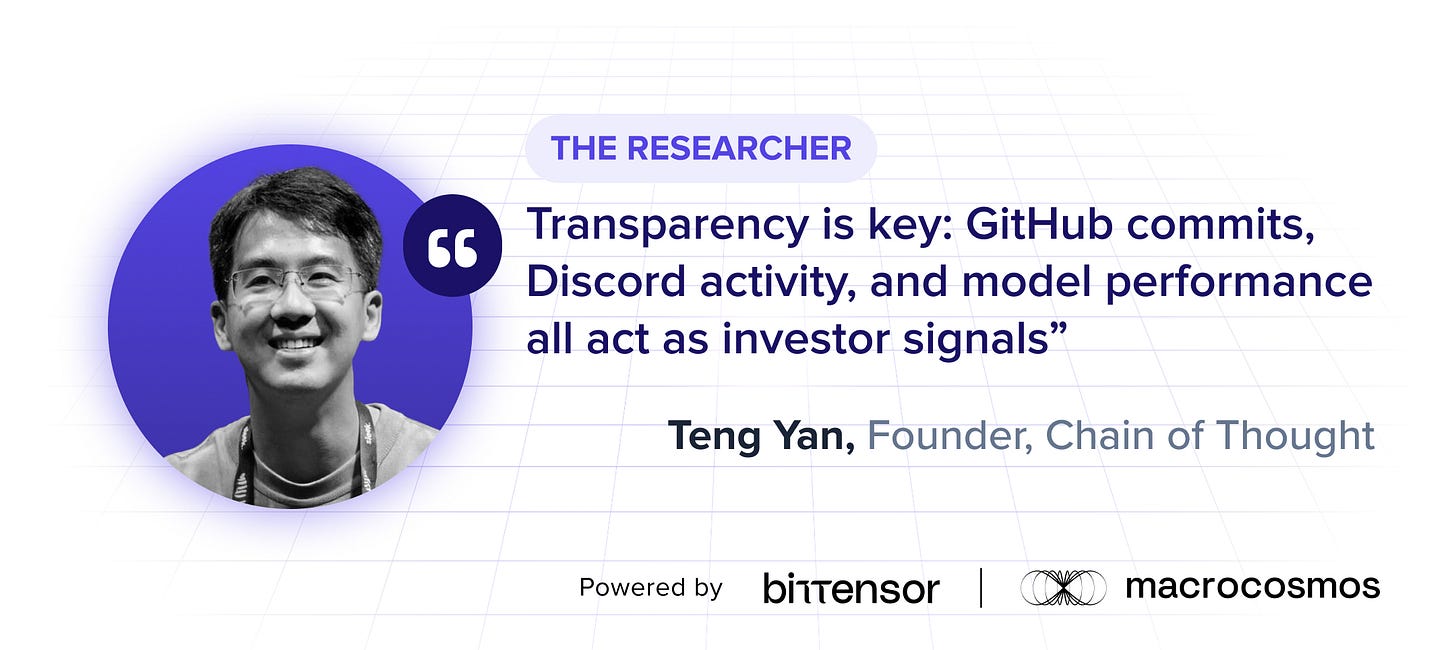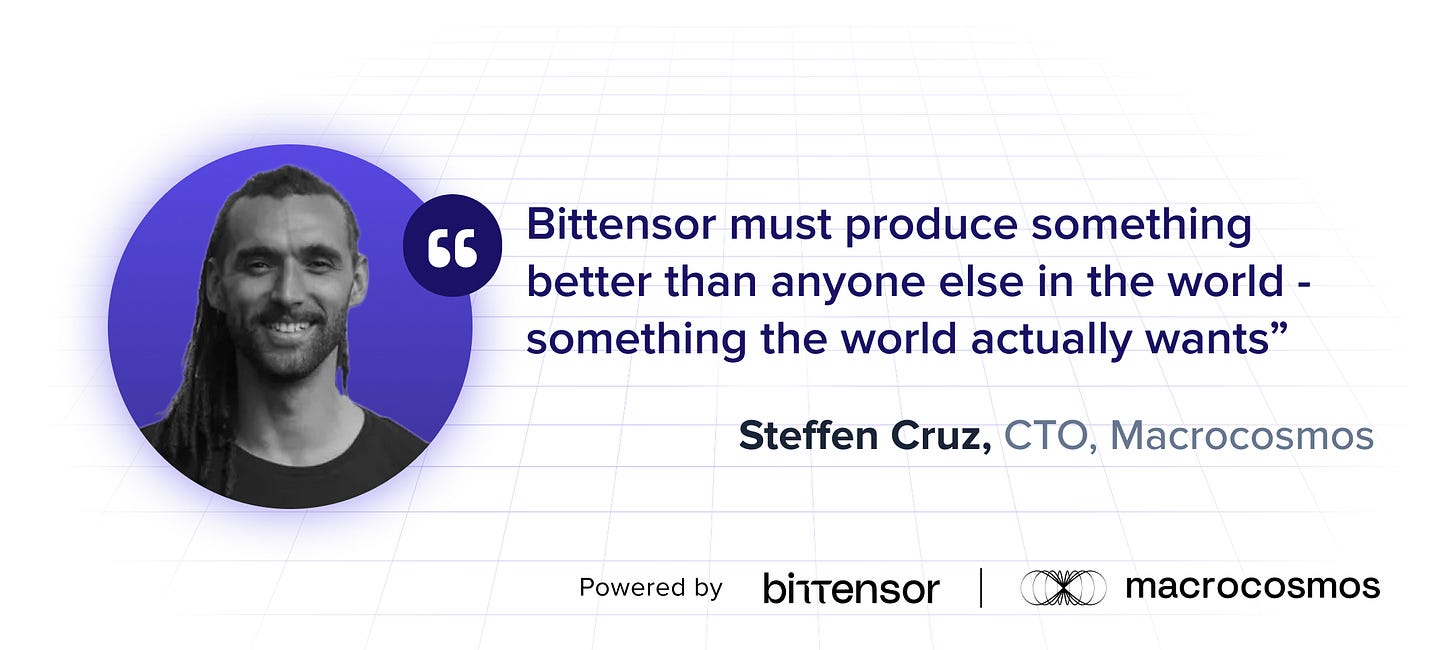The big ask: What does Bittensor need to do to breakthrough?
Ahead of Bittensor's Endgame summit, we ask six key voices what the protocol needs to do to break out of its bubble and into the mainstream
If you’re into Bittensor, you’ll have asked yourself this question a hundred times: what does the protocol need to do to breakthrough?
‘A bubble’, ‘a cult’, ‘its own world’: Bittensor has always been a separate entity, focusing on its internal dynamics rather than its outward perception across Web3 and beyond. And this internal focus is one of the protocol’s strengths.
But as dTAO challenges subnets to commercialize, the need to expand awareness beyond our own bubble becomes more and more pressing. So, ahead of Endgame - Bittensor’s first annual summit - we’re asking key figures in our ecosystem for where they think our breakthrough lies.
Read on to hear six perspectives on how Bittensor can move beyond its current reach - and join us in person at Endgame for a more in depth discussion from our founders, plus a panel debating these issues before our core audience.
‘Success won’t just come from designing clever incentives’
Sami Kassab, co-founder, Crucible Labs
‘Crypto still hasn’t found its breakout use case: outside of Bitcoin, stablecoins, and speculating, most networks struggle to show meaningful adoption. Utility protocols—whether for compute, storage, or other services—often generate little real usage or revenue, despite years of effort and investment. So for Bittensor to break through, it needs to prove that decentralized networks can create useful services that people actually pay for. Not theoretical demand, but real usage generating tens of millions in ARR and growing from there. That’s going to require subnets to operate more like businesses. Success won’t just come from designing clever incentives—it’ll come from building products that people want on top, and putting just as much energy into sourcing demand as they do into supply.’
‘There’s strong potential in integrating EVM compatible decentralised applications’
Max Sebti, Co-founder, SN44
‘With a few strategic moves, Bittensor could see real progress towards achieving its breakthrough. I reckon there’s strong potential in integrating EVM compatible decentralised applications that make use of subnets as interconnected to build their own infrastructure, each contributing to the bigger picture. There’s also great opportunity to build DeFi protocols that draw in more liquidity, giving the ecosystem a boost and pushing greater participation. On top of that, I think subnet owners now have a unique opportunity to rethink their approach, moving away from the intricate technical detail of before and presenting their work in a clear, consumer friendly way to appeal to a broader crowd.’
‘Bittensor must manage its image and prioritize quality over rapid subnet expansion to thrive.’
Cryptor, KOL
‘I strongly believe in Bittensor and the #dTAO mechanics, but at its core, Bittensor is still a crypto project. After three market cycles, I’ve become more realistic—less driven by hype and more focused on risk management, a mindset that applies to every crypto project, including Bittensor. This cycle brings token dilution, inflation, and the rotation of thin liquidity, shaping the main perception of crypto. Bittensor must manage its image and prioritize quality over rapid subnet expansion to thrive. Sustainable growth and strong alpha tokens with real utility are essential. At the end of the day, a subnet is a business—it must generate revenue, plain and simple. It needs a clear purpose, reflected in its tokenomics, giving investors a reason to buy beyond hype and speculation. Long-term success depends on subnets unlocking real-world AI utility and generating revenue tied to their alpha tokens. Bittensor must also bridge Web3 and Web2, making adoption seamless for mainstream users. These are the fundamentals. If Bittensor masters them, its success won’t just be likely—it will be inevitable.’
‘Transparency is key: GitHub commits, Discord activity, and model performance all act as investor signals.’
Teng Yan, Researcher
‘For Bittensor to break through, subnets must create real, value-generating use cases that drive demand for their native tokens—not just rely on emissions as funding. Founders need to actively bootstrap token demand through business development, marketing, and clear value propositions. Transparency is key: GitHub commits, Discord activity, and model performance all act as investor signals. If you’re not shipping or communicating, the market will move on. Looking ahead, integrating advanced DeFi tools—like concentrated liquidity AMMs and permissionless Alpha pools—could significantly boost capital efficiency and unlock deeper liquidity across the network.’
‘Bittensor must produce something better than anyone else in the world - something the world actually wants.’
Steffen Cruz, Co-founder and CTO, Macrocosmos
‘Bittensor needs to earn its breakthrough on merit, not claim that we deserve it by virtue of our protocol’s superior design or limitless potential. It must produce something better than anyone else in the world - and ideally, something that the world actually wants. Thankfully, Bittensor’s diversity is its strength. An open, distributed, competitive environment is much more likely to stimulate innovation, and the teams who harness the protocol’s dynamics most effectively are more likely to succeed. Almost all of the world’s problems are ultimately about incentives and their alignment - or misalignment. That’s what Bittensor does best, and it’s why we believe it’s by far the best platform on which to build decentralized AI.’
‘The biggest breakthrough will come when subnet teams realise they shouldn't be building the product.’
Shad, co-founder, SN6
‘Foundation wise, it needs to not change. There are always grumbles in the community, but consider this: Bittensor is the only major L1 project without a true foundation (the OTC explicitly states that it plans to dissolve). The only one without a marketing budget, without a dedicated ecosystem team. Yet it still beats every L1 in organic builder adoption and ecosystem health, even post-cataclysmic event (sic: dTAO). In my opinion, the biggest breakthrough will come when subnet teams realise they shouldn't be building the product, they're pure infrastructure, and that they need to incentivise more builders to come and build on top of their backends. That's where true network effect takes place for infrastructure primitives. Until we have that realisation, we will be constrained by the acquisition capabilities of single entities, whom are mostly tooled for research and core engineering, not building product nor acquiring millions of users. As ChatGPT wrappers are to frontier models, we must have the same heuristic to truly break through.’
Thanks to all of our contributors for sharing their thoughts.
Want to participate in the next roundtable? Join our Telegram and Discord communities and let us know.




